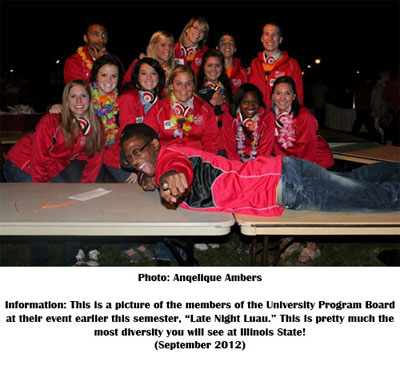A Reflection on Race in Normal
Normal is a rather conservative town, the dead giveaway is the amount of Mitt Romney posters you see while driving through the neighborhood. The people of Normal are mostly Republican and to be honest there is not much diversity here. Although the university brings diversity to Normal there is still a large  amount of separation among the students; meaning that in most cases a party or event is predominantly either black or white. There is never a noticeable intermingling of the two. Perhaps this is because both the black and white students are unfamiliar with each other. Many black students are from areas in Chicago where most of their neighbors are black, while some white students come from farm towns where there were literally no black people at all. Blacks may be apprehensive about socializing with whites, having the false perception that all whites are racist or uninterested in a relationship with blacks. Additionally, the media enforces many negative stereotypes about blacks and to a student who has not grown up around any African Americans, he/she may be cautious around them. Furthermore, Hispanics and Asians also separate themselves, spending most of their free time with individuals of their own race. While there are many students who embrace cultural differences and attempt to befriend people of all backgrounds, the social events and parties still remain racially separated. Even the fraternities and sororities are separated by race.
amount of separation among the students; meaning that in most cases a party or event is predominantly either black or white. There is never a noticeable intermingling of the two. Perhaps this is because both the black and white students are unfamiliar with each other. Many black students are from areas in Chicago where most of their neighbors are black, while some white students come from farm towns where there were literally no black people at all. Blacks may be apprehensive about socializing with whites, having the false perception that all whites are racist or uninterested in a relationship with blacks. Additionally, the media enforces many negative stereotypes about blacks and to a student who has not grown up around any African Americans, he/she may be cautious around them. Furthermore, Hispanics and Asians also separate themselves, spending most of their free time with individuals of their own race. While there are many students who embrace cultural differences and attempt to befriend people of all backgrounds, the social events and parties still remain racially separated. Even the fraternities and sororities are separated by race.
Furthermore, just like many other towns, a specific part belongs to the minorities. In Normal there is not a specific area where only minorities live, but driving down main street and slowly crossing over into Bloomington a certain change becomes known immediately; especially when driving down Market Street. In Bloomington the neighborhood is not as clean or suburban looking. There is low-income housing, which helps seclude the poor from the rich. To the people of Normal, Bloomington is viewed as a sketchy place where drugs and lack of money seem to be the main issues. There are many programs in Bloomington, aimed at helping those less fortunate. I volunteered at a place known as “Western Avenue,” this program consisted of afterschool care and supplying students with school supplies, books, and other learning activities. The borders of Normal and Bloomington separate the less fortunate, perhaps this is a design to help avoid crime and the intermingling of minorities in the conservative town of Normal. -- Angelique Ambers